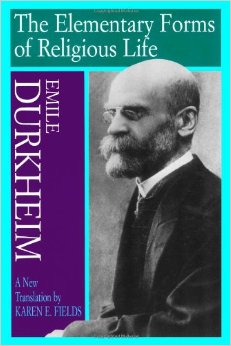In the book, The Elementary Forms of Religious Life, I found Emile Durkheim’s conclusions regarding the objective reality behind religion to be sound and applicable for both the study and the practice of religion today. Durkheim seems justified in stating that, “the unanimous feeling of believers down the ages cannot be mere illusion;” thus, it follows that “religious experience” actually engenders sensations and sensibilities that are grounded in reality.[1] However, the ideas and perceptions that arise from this grounded experience do not necessarily conform objectively to the reality in which they are grounded. In fact, Durkheim rightly asserts that the infinite variations, in different times, through which this reality has been (and can be) conceived demonstrate that these conceptions have typically failed to accurately express it.[2] Thus, prior to addressing “the demands of practicality and vital necessities” that force us to contemplate that which science cannot investigate (i.e. prior to “doing” theology), we must first apply a scientific analysis to the sensations of religious life.
One conclusion of Durkheim’s analysis is that, “Religious representations are collective representations that express collective realities; rites are ways of acting that are born only in the midst of assembled groups and whose purpose is to evoke, maintain, or recreate certain mental states of those groups.”[3] Through intense rituals, which bring about “a state of [collective] effervescence that alters the conditions of psychic activity,” the collective consciousness will tend to transfigure and imagine the clan or society in some sort of sacred form or concept such as a plant, an animal, or a god.[4] For example, the religious totem, once conceived, emblematized, and affirmed through rituals, symbolizes “both the god and the society, [which means that] the god and the society are the same.”[5] Therefore, through rituals that sacralize certain collective representations, religion serves to strengthen the solidarity of a given society itself.
As a person of faith, I do not believe it is sacrilegious to identify Divinity with the whole of human society, that is, with the whole of humanity. One need not resort to pantheism, because as Durkheim recognized, society-itself is “a reality sui generis; it has its own characteristics.”[6] Thus, the representations that express both God and society, as Durkheim states, “have an altogether different content from the purely individual representations.”[7] Of course, Durkheim’s conception of the collective consciousness does not affirm an metaphysical reality sui generis, but rather an epistemological one. Still, Durkheim’s conception neither denies nor affirms any theological claim about said reality being divinely transcendent.
It is clear that our tumultuous world needs a system of morals that guides our actions toward peace, justice, freedom, equality, and love of all of humanity, but science meets its limits in the realm of morality. Moral philosophy may very well inform the masses (including religion) of the “right” way to live. However, religion serves its optimal function in creating the sacred, and thereby espousing faith, which as Durkheim states, “is above all a spur to action.”[8] It is this spur to action—guided by a global ethic, consisting of collective representations, which positive and negative rites evoke, maintain, and re-create into sacred principles—that is desperately needed to unite humanity into a global moral community that moves to actualize those sacred principles in the world.[9] However, the privileged position that religion once had in interpreting the natural world must be conceded to science.[10] That is, religious speculation must always reckon with science on science’s terms; it “should affirm nothing that science denies, deny nothing that science affirms, and establish nothing that does not directly or indirectly rest on principles taken from science.”[11]
Tragically, somewhere down the line, religious rituals began to sacralize a god who was wholly other, separated from society, and even opposed to it. Thankfully, Durkheim rightly asserts that, “religion seems destined to transform itself rather than disappear.”[12] As such, today’s religious practitioners and gatekeepers must re-envision and transform religion into “a unified system of beliefs and practices relative to sacred things,” which strives to unite all people of the world, not into “a single moral community,” as Durkheim states, but rather into a global moral community.[13] Instead of sacralizing things that divide humanity, such as conceptions of a god who “chooses” one People over another or ordains this or that war, religion must acknowledge that society-itself is sacred. Religion must affirm universal humanity-itself as sacred, and establish a universal sacred bond of kinship among all peoples, since indeed, this is what its true function is. In our 21st Century, globalized, and pluralistic context, and in the age of the Internet, YouTube, and social media, it is necessary to investigate the possibility of fostering or imitating positive and negative rites both virtually and globally.
[1] The Elementary Forms of Religious Life, ed. Karen E. Fields (New York: Free Press, 1995), 420.
[2] Ibid.
[3] Ibid., 9.
[4] Ibid., 208, 424.
[5] Ibid., 208.
[6] Ibid., 15.
[7] Ibid.
[8] Ibid., 432.
[9] Collective representations of sacred principles such as peace, justice, freedom, equality, and love of all of humanity.
[10] Of course, this means that science itself must be its own vehement critic to ensure its own intellectual honesty, but the moment religionists begin to address scientific claims they must cease “doing” religion and adopt the methods of scientific enquiry. Even as science grows (including the social sciences, e.g., sociology, psychology, etc.), however, religion still serves a necessary function for society—albeit in a transformed manifestation.
[11] The Elementary Forms of Religious Life, 433.
[12] The Elementary Forms of Religious Life, 432.
[13] Ibid., 44.




